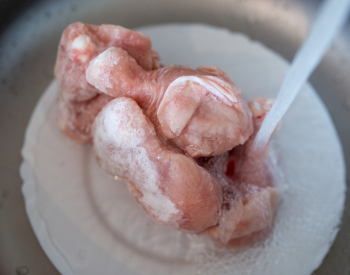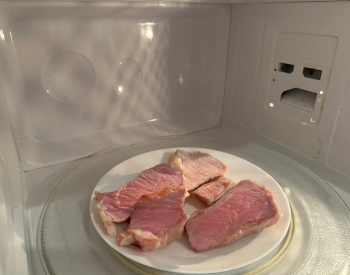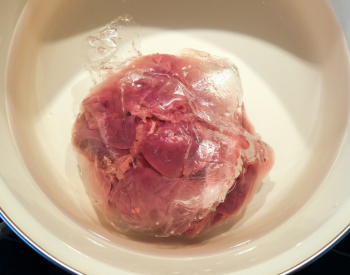In every home kitchen, there's a cycle as old as cooking itself. You've been there – standing before the freezer, choosing from its frosty depths a cut of meat for dinner, only to find it's frozen solid. So, how do you defrost meat properly, efficiently, and safely? In this comprehensive guide, we'll answer your most pressing questions about the right ways to thaw meat, ensuring maximum flavor and safety for professional chefs and home cooks alike.
Defrosting Meat Safely – Why It Matters
The first thing we must address is the 'why'—why does it matter how you defrost meat? Bacteria are the primary concern here. When meat gets warm, bacteria can begin to multiply. That's why it's essential to understand the best practices for defrosting meat. The keywords for defrosting meat safely are temperature control and timing.
Methods Of Thawing Meat
There is a culinary conundrum that home chefs, amateur cooks, and even professionals frequently encounter: the battle against the frozen fortress of meat stashed in the freezer. How often have you looked at that icy, rock-hard chunk and wondered how to transform it into a succulent, juicy delight? It's all about mastering the art and science of thawing. Whether you're cooking a thick steak for a barbecue, preparing a Sunday roast, or need to get dinner on the table quickly, knowing how to thaw meat properly is a fundamental kitchen skill.
Understanding various meat thawing methods, from the traditional refrigerator method to the quick microwave method and even direct cooking from frozen, is essential for the safety and flavor of your dishes. Each technique comes with its benefits and drawbacks, so knowing when to use which method can elevate your culinary game. Join us as we embark on a journey, exploring the diverse terrain of meat thawing methods, where you'll learn how to ensure your next meal is safe, delicious, and free of any frosty reminders of the freezer.
Refrigerator Thawing
The safest method to defrost meat is refrigerator thawing. It might be the slowest method, but it's certainly the safest as it keeps the meat at a constant, safe temperature the entire time. You can leave the meat in the refrigerator for a day or two, depending on the size and cut of the meat. Remember to place the meat in a container to catch any leaks that might contaminate other foods.
Cold Water Thawing
If you're looking for a quicker method, you can opt for cold water thawing. This technique involves putting your meat in a leakproof zip bag and submerging it in cold water. Remember to change the water every 30 minutes to maintain the temperature. While faster than fridge thawing, this method requires more attention.
Microwave Thawing
When you're pressed for time, microwave thawing can be a lifesaver. While this method is fast, it can lead to uneven thawing and change the quality of your meat. After defrosting in the microwave, cooking your meat immediately is crucial to prevent bacterial growth.
Can I Thaw During Cooking?
Yes, you can cook frozen meat directly in some cases. However, this method usually extends the cooking time by approximately 50% compared to fully thawed meat.
Is It Better To Thaw Meat In Water Or Air?
The decision to thaw meat in water or air comes down to specific circumstances: time and convenience. If you have ample time, thawing the meat in the refrigerator (using air) is considered the safest method. It maintains the meat at a safe, consistent temperature throughout the thawing process, reducing the risk of bacterial growth. However, this process can be slow and requires planning, as it can take up to 24–48 hours to fully thaw a large piece of meat.
On the other hand, if you are short on time, thawing meat in cold water is a faster and still safe method. As water is a more efficient conductor of heat than air, it speeds up the thawing process significantly, allowing you to defrost even large cuts of meat in a matter of hours. The key is to keep the meat in a sealed plastic bag and change the water every 30 minutes to keep the temperature consistent and safe.
Ultimately, both methods have their merits. Refrigerator thawing is slower but requires less attention, while cold water thawing is faster but demands more active involvement. Therefore, the best method depends on your available time and the degree of convenience you desire.
Tips For Safe Meat Defrosting
Below are some tips for defrosting your meat without spreading harm to guests:
- Never thaw meat at room temperature: Leaving meat out on the counter can lead to the rapid growth of harmful bacteria.
- Plan ahead: If possible, plan your meals a few days ahead of time to allow for safe defrosting in the fridge.
- Defrosted meat should be cooked as soon as possible: Once defrosted, meat should be cooked within 24–48 hours.
Does Cold Water Thaw Meat Faster?
Yes, it's true. Cold water does thaw meat faster than refrigeration. This method, known as the cold-water thawing technique, accelerates the process by taking advantage of the principle of heat transfer. Since water conducts heat better than air, frozen meat can absorb the heat from the water more rapidly, resulting in a faster defrosting process. This method typically involves submerging your sealed meat in a bowl or sink full of cold water, which is changed every 30 minutes to maintain a consistent temperature. While this technique requires a little more attention than refrigerator thawing, it's a safe and quicker alternative when you need your meat ready to cook in hours rather than days.
Why Can’t You Defrost Meat Directly In Water?
While the cold-water thawing technique is an effective way to defrost meat quickly, it is vital to remember that the meat should never be defrosted directly in water without being in a sealed, leak-proof bag. This is because when meat is directly exposed to water, it can lead to waterlogged meat, resulting in a change of texture and potential loss of flavor. Moreover, it could also pose a risk of bacterial contamination if the water is not cold enough. Bacteria can multiply rapidly in a warm environment, and even a short time in a “danger zone” temperature (between 40°F and 140°F) can render your meat unsafe to consume. Therefore, meat should always be kept in a leak-proof plastic bag when using the cold-water thawing method, ensuring your food's quality and safety.
Wrapping Up
Knowing how to defrost meat safely and efficiently is essential in every kitchen. Understanding the different thawing techniques and when to use them can greatly enhance your culinary experiences, ensuring your meals are delicious and safe. Remember, maintaining control over the temperature and timing is the key to defrosting meat. Happy cooking!









